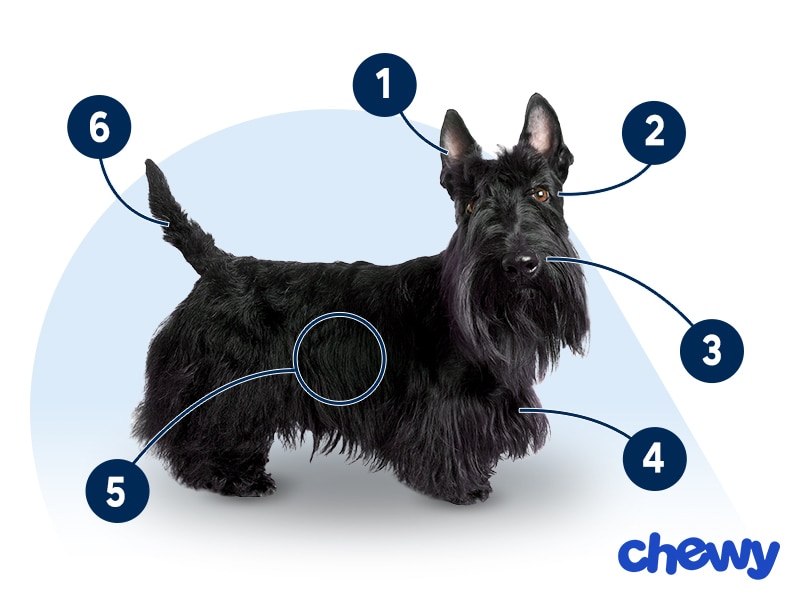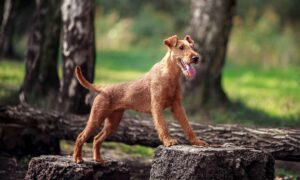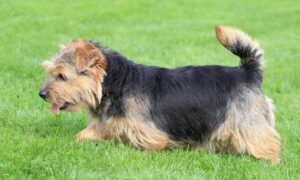Scottish Terrier
Updated June 30, 2025
Scottish Terrier
Updated June 30, 2025
Known for their bushy brow and beard, Scottish Terriers are both affectionate companions and independent thinkers. These smart pups do best with early, consistent training and a quiet home where they can spend plenty of one-on-one time with their family.
Free-Spirited, Self-Assured, Attentive
18–22 pounds
10 inches
12 years
Black, Black Brindle, Brindle, Red Brindle, Silver Brindle, Wheaten
The Scottish Terrier is often described as a big dog in a small package. These handsome pups will keep you on your toes with their confident, spunky personality. After a few days with a Scottie, you’ll learn why this breed is nicknamed The Diehard: Once they set their mind to something (like winning a game of tug-of-war), they’re surprisingly persistent.
Their courageous and determined temperament requires early, consistent training to promote good manners. But with an experienced pet parent’s guidance, a well-trained and socialized Scottie will quickly win you over with their deep affection and devoted companionship.
Scottish Terrier Characteristics
Scottish Terrier Appearance
The Scottie’s looks capture the breed’s always-alert personality, particularly in pups’ pricked-up ears, bright eyes, and erect tail.

- Ears
Scottie Terrier ears are small and pointed. They sit high up on the head and are covered in soft fur.
- Eyes
The dark, piercing eyes of a Scottie are wide-set, almond-shaped, and rest beneath a strong brow.
- Nose
Whether you have a black Scottie or one with a lighter coat, these dogs always have a black nose at the end of a long muzzle.
- Coat Length
Scottie dogs have a double coat with a wiry outer layer and a dense, soft undercoat. Around the body, the coat is hand-stripped and kept at a medium length. The hair around the dogs’ beard, legs, and lower body is kept longer, creating a distinct, shaggy appearance.
- Coat Color
Scottish Terrier coats come in a range of colors: solid black; solid wheaten; or black, red, or silver brindle (a pattern like tiger stripes).
- Tail
Scotties have a proud, erect tail set high on the back that stands either straight up or with a slight curve. Their tail is about 7 inches long and is covered in coarse hair.
Scottish Terrier Temperament
Scotties are strong-willed and independent dogs, but they are also affectionate companions who love to hang out with their family.
Although most Scotties aren’t known for being cuddle bugs, they still enjoy being in your company and will happily sit next to you on the couch. But when it comes to strangers, this breed is often aloof and not all that interested in making new friends. (This is when socializing your Scottie puppy becomes important.)
The Scottish Terrier personality is influenced by their history as solo hunters in the Scottish Highlands. Because they were bred to go after small vermin, this breed can harbor a prey drive toward other animals, says Jo-Anne Riddle, president of the Scottish Terrier Club of Greater Washington, D.C., and an AKC Breeder of Merit.
Reputable breeders breed Scotties for more relaxed, amicable temperaments. When properly bred, socialized, and trained, “they can be very friendly,” Riddle says.
However, even the best-behaved Scotties can be impatient with young children who might not understand the dog’s boundaries. For that reason, the terriers may not be the best choice for families with young kids.
As a working dog, Scottie Terriers need to keep their paws moving and the wheels in their big brain turning. These sport dogs excel at everything from scent work to barn hunting, according to Susan Finn, former president of the Scottish Terrier Club of Greater New York and an AKC Breeder of Merit.
“They do love everything,” she says. “But most of all, they love spending time with their people.”
How to Care for a Scottish Terrier
Though Scottie care is straightforward in some areas, their headstrong personality requires pet parents to step up their training game. Scottish Terrier puppies should learn basic obedience and be socialized early. This can help prevent separation anxiety and keep them on their best behavior when they meet new people and other animals.
Along with training, maintaining the classic Scottie coat means setting aside extra time—and money—for specialized grooming.
Grooming
Training
Diet
Exercise
Environment
Scottish Terrier Health
Scotties are generally a healthy breed with an average lifespan of 12 years, according to the Scottish Terrier Club of America. Although they can be prone to certain health conditions, modern health testing has eliminated many of the most common diseases, Riddle says.
Ask your breeder about health testing to ensure your Scottish Terrier puppy has been tested for genetic conditions.
- Von Willebrand Disease (vWD): This is an inherited bleeding disorder that prevents a dog’s blood from clotting properly. Dogs with vWD bruise and bleed more easily, and they can bleed excessively during surgery. There’s no cure, but with proper management, many dogs can still live a normal lifespan.
- Bladder cancer: According to the breed club, the Scottie breed is 18% more likely to develop bladder cancer than other breeds. Take your pup to the vet immediately if you notice a change in urinary habits, as this may be an early sign of bladder cancer.
- Scottie cramp: This genetic condition causes benign muscle spasms, stiffness, and immobility triggered by moments of stress, high activity, or excitement. It’s a painless, episodic condition that doesn’t affect the dog’s overall health.
- Cataracts: Scotties may be susceptible to cataracts, which causes clouding in the eye and may reduce vision. Cataracts are more common in older Scotties and can be treated with surgery.
Scottish Terrier History
The history of the Scottish Terrier dates back to the 13th century in the Scottish Highlands, where several types of terrier dogs were bred as four-legged vermin control.
“They’re bred to work in packs away from people,” Riddle says, which explains the contemporary Scottie’s aloof, independent personality.
Sottish Terriers are actually just one of the terrier breeds employed for pest control in Scotland, along with the Dandie Dinmont Terrier and the Irish Terrier. It wasn’t until the late 1800s that the Scottie we know today was bred consistently enough to be established as a distinguished breed.
The Scottish Terrier Club of England formed in 1882, followed by the Scottish Terrier Club of Scotland in 1888 and the Scottish Terrier Club of America in 1990. The American Kennel Club recognized the Scottie in 1885.







